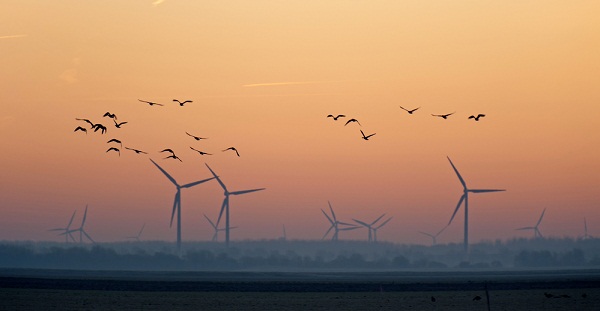The growth of wind power, if undertaken with reasonable care, should pose no risk to any particular bird species in Canada, according to a new peer-reviewed study. The study also suggests that highly publicized bird mortality figures out of the U.S. and Europe could be on the high side.
“Canadian Estimate of Bird Mortality Due to Collisions and Direct Habitat Loss Associated with Wind Turbine Developments” [PDF] was one of several studies undertaken as part of special issue of the journal Avian Conservation & Ecology that focused on the impact of human activities on the mortality of birds in Canada.

The researchers did find that, on average, a wind turbine in Canada results in 8.2 bird deaths per year, and they estimated that a 10-fold increase in installed wind capacity in the next 10-15 years “could lead to direct mortality of approximately 233,000 birds/year, and displacement of 57,000 pairs” resulting from habitat loss.
But the researchers put those numbers in perspective:
[T]hese values are likely much lower than those from collisions with some other anthropogenic sources such as windows, vehicles, or towers, or habitat loss due to many other forms of development. Species composition data suggest that < 0.2% of the population of any species is currently affected by mortality or displacement from wind turbine development. Therefore, population level impacts are unlikely, provided that highly sensitive or rare habitats, as well as concentration areas for species at risk, are avoided.
One of the most interesting aspects of the study was that mortality figure of 8.2 birds per year per turbine – 8.2 ± 1.4 birds (95% C.I.), to be precise. The researchers said this was a higher estimate than had been found in other research into turbine-related bird mortality in Canada, “due mainly to incorporation of two additional correction factors: the proportion of birds likely to fall outside a 50 m search radius, and the proportion of birds killed at other times of year.”
Yet even with these expanded correction factors, the 8.2 figure is still notably lower than a bird mortality estimate for the U.S. that is frequently cited by wind power critics, from Albert Manville of the U.S. Fish & Wildlife Service (we discussed that study a bit here).
Manville (2009) suggested that annual bird mortality from wind power projects in the United States was 440,000 birds, which equals about 19 birds per turbine based on an estimated 23,000 turbines at the time. However, he did not provide any details on how this estimate was derived.
The Canadian researchers also arrived at a mortality rate far lower than the recent, controversial K. Shawn Smallwood paper. The Canadian researchers suggested there were a number of reasons to believe Smallwood’s numbers were too high:
For example, he used larger corrections for birds falling outside a 50 m radius; by assuming a logistic distribution of carcasses, he concluded that carcasses could fall up to 156 m away from an 80 m turbine, though this is farther than Hull and Muir (2010) suggested is likely. Furthermore, his analysis assumes that mortality is proportional to the rated capacity of the turbines, but particularly for newer turbines this seems unlikely; for example, there is only a 19% increase in the blade swept area between a 1.5 and 3.0 MW turbine.
The study was also skeptical of an often-cited Spanish estimate of 300-1,000 birds per turbine.
Their very high mortality estimates were based on assumptions that searcher efficiency was extremely low, scavenger rates were very high, and large numbers of carcasses fell outside the search areas. However, no evidence was presented to support those assumptions, and it is quite possible that mortality rates were not actually any higher than those in Canada.
If you’re wondering which things were determined to be the biggest bird killers in the other Avian Conservation & Ecology studies, this press release from the American Bird Conservancy (a frequent wind industry critic) tells the story well. Key passage: “[T]he median estimate of cat-caused mortality – almost 200 million bird deaths per year – was about six times greater than the next leading mortality estimate of about 32 million attributed to car collisions. The third-leading cause was collisions with buildings or homes, with a rate of about 22 million bird deaths per year.”